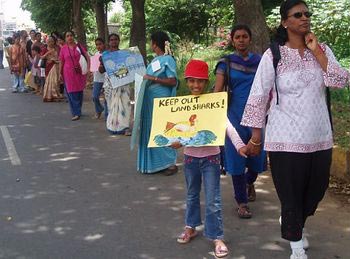- ON THE DECADE
- THE DECADE'S CAMPAIGN
- REPORTING ON PROGRESS
- THE DECADE'S PROGRAMMES
- FOCUS AREAS
-
- Access to sanitation
- Financing water
- Gender and water
- Human right to water
- Integrated Water Resources Management
- Transboundary waters
- Water and cities
- Water and energy
- Water and food security
- Water and sustainable development
- Water and the green economy
- Water cooperation
- Water quality
- Water scarcity
- FOCUS REGIONS
- RESOURCES FOR
- UN e-RESOURCES
Water for Life Voices
Knowledge Bank. Protection of Bangalore Lakes for Posterity, India
Organization: Environment Support Group (ESG)
 Bangalore, the capital of Karnataka state, is home to 10 million people. But rapid urbanisation has put traditional water sources at risk. Bangalore draws about 1,400 million litres per day (MLD) from River Cauvery which meets half the city's needs. The rest is drawn from groundwater sources, the quality and quantity of which is fast degrading.
Bangalore, the capital of Karnataka state, is home to 10 million people. But rapid urbanisation has put traditional water sources at risk. Bangalore draws about 1,400 million litres per day (MLD) from River Cauvery which meets half the city's needs. The rest is drawn from groundwater sources, the quality and quantity of which is fast degrading. Yet Bangalore can’t draw more from the river. The Cauvery flows through many states with ever increasing demands from industrial, agricultural and urban users, and there is a cap on withdrawals. Historically, communities across the region developed a network of lakes to form a larger watershed. This provided security in this semi-arid region otherwise dependent on seasonal rivers. The network also helped recharge groundwater, and surface water for a second crop in the dry season, improved the local climate and supported biodiversity in rich wetland ecosystems.
Until 20 years ago, Bangalore had over 600 such lakes. Today less than 450 survive in various stages of deterioration. This has had a debilitating impact on groundwater levels. ESG began to organize local communities and ran campaigns to promote conservation of lake systems. Local communities stepped up to protect their lakes.
ESG created a committee involving nine government agencies and officiated by a sitting judge of the Karnataka High Court. The committee, with ESG’s help, was tasked with developing a plan to protect and conserve Bangalore’s lakes. The plan anticipates that when the 450 lakes are completely rehabilitated along with interlinking canal networks, a massive absorption of rain water into groundwater aquifers can take place. Well levels will rise, water quantities and quality will improve, and there will be a decrease in energy demands for drawing water. For communities based on subsistence farming, which supply vegetables and other produce to the city, this means safer water, and better crop growth. Cattle grazing communities can anticipate access to safer water and thus better milk yields.
The plan is also designed to ensure the ongoing rehabilitation of lakes will provide wetland habitats, increasing biodiversity.
Keywords: access to water, ecosystems, groundwater, water cooperation, water quality.
Location: India, Asia and the Pacific
Corresponding websites:
>> More information about the initiative
>> Wise Use and Conservation of Lakes of the Bangalore region as Public Commons
>> ESG website
>> Intro
>> Progress
>> Pride
>> Hope
>> Your Voice
>> End
>> Full Exhibition
>> Ecosystems
>> Empowering communities
>> Food security
>> Gender and water
>> Groundwater
>> Hygiene
>> Open defecation
>> Participation
>> Sustainable development
>> Water and culture
>> Water and disasters
>> Water and energy
>> Water and health
>> Water for cities
>> Water efficiency
>> Water quality
>> Water scarcity
>> Voices of experts
>> Voices from business
>> Voices from the civil society
>> Voices from the field: case studies
>> Africa
>> Asia and the Pacific
>> Europe
>> Latin America and the Caribbean
>> Middle East
>> Oceania
>> Decade’s achievements. From MDGs to SDGs
>> Five years of UN-Water "Water for Life"
Awards 2011-2015
>> Water for Life Voices
Copyright | Terms of use | Privacy notice | Site Index | Fraud alert | Help




